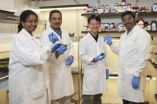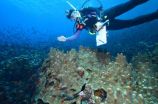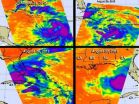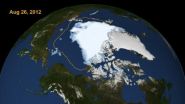(Press-News.org) EUGENE, Ore. -- (Aug. 27, 2012) -- Refrigerating coal-plant emissions would reduce levels of dangerous chemicals that pour into the air -- including carbon dioxide by more than 90 percent -- at a cost of 25 percent efficiency, according to a simple math-driven formula designed by a team of University of Oregon physicists.
The computations for such a system, prepared on an electronic spreadsheet, appeared in Physical Review E, a journal of the American Physical Society.
In a separate, unpublished and preliminary economic analysis, the scientists argue that the "energy penalty" would raise electricity costs by about a quarter but also reap huge societal benefits through subsequent reductions of health-care and climate-change costs associated with burning coal. An energy penalty is the reduction of electricity available for sale to consumers if plants used the same amounts of coal to maintain electrical output while using a cryogenic cleanup.
"The cryogenic treatment of flue gasses from pulverized coal plant is possible, and I think affordable, especially with respect to the total societal costs of burning coal," said UO physicist Russell J. Donnelly, whose research team was funded by the U.S. Department of Energy for the work detailed in the published journal article.
"In the U.S., we have about 1,400 electric-generating unit powered by coal, operated at about 600 power plants," Donnelly said. That energy, he added, is sold at about 5.6 cents per kilowatt-hour, according to a 2006 Congressional Budget Office estimate. "The estimated health costs of burning coal in the U.S. are in the range of $150 billion to $380 billion, including 18,000-46,000 premature deaths, 540,000 asthma attacks, 13,000 emergency room visits and two million missed work or school days each year."
In their separate economic analysis, Donnelly and UO research assistant Robert E. Hershberger, also a co-author on the journal paper, estimate that implementing large-scale cryogenic systems into coal-fired plants would reduce overall costs to society by 38 percent through the sharp reduction of associated health-care and climate-change costs. Not in the equation, Donnelly said, are the front-end health-care costs involved in coal extraction through mining.
The cryogenic concept is not new. Donnelly experimented briefly in the 1960s with a paper mill in Springfield, Ore., to successfully remove odor-causing gasses filling the area around the plant using cryogenics. Subsequently the National Science Foundation funded a major study to capture sulfur dioxide emissions -- a contributor to acid rain -- from coal burning plants. The grant included a detailed engineering study by the Bechtel Corp. of San Francisco.
The Bechtel study showed that the cryogenic process would work very well, but noted that large quantities of carbon dioxide also would be condensed, a consequence that raised no concerns in 1978. "Today we recognize that carbon dioxide emissions are a leading contributor to climate-warming factors attributed to humans," Donnelly said.
Out came his previously published work on this concept, followed by a rigorous two-year project to recheck and update his thermodynamic calculations and compose "a spreadsheet-accessible" formula for potential use by industry. His earlier work on the cryogenic treatment of coal-plant emissions and natural gas sources had sparked widespread interest internationally.
While the required cooling machinery would be large -- potentially the size of a football stadium -- the cost for construction or retrofitting likely would not be dramatically larger than present systems that include scrubbers, which would no longer be necessary, Donnelly said. The new journal article does not address construction costs or the disposal of the captured pollutants, the latter of which would be dependent on engineering and perhaps geological considerations.
According to the Physical Review E paper, carbon dioxide would be captured in its solid phase, then warmed and compressed into a gas that could be moved by pipeline at near ambient temperatures to dedicated storage facilities that could be hundreds of miles away. Other chemicals such as sulfur dioxide, some nitrogen oxides and mercury also would be condensed and safely removed from the exhaust stream of the plants.
Last December the U.S. Environmental Protection Agency issued new mercury and air toxic standards (MATS), calling for the trapping of 41 percent of sulfur dioxide and 90 percent of mercury emissions. A cryogenic system would do better based on the conservatively produced computations by Donnelly's team -- capturing at least 98 percent of sulfur dioxide, virtually 100 percent of mercury and, in addition, 90 percent of carbon dioxide.
"This forward-thinking formula and the preliminary analysis by these researchers offer some exciting possibilities for the electric power industry that could ultimately benefit human health and the environment," said Kimberly Andrews Espy, UO vice president for research and innovation. "Scientists at the University of Oregon are continuing to develop new ideas and advanced materials to foster a sustainable future for our planet and its people."
INFORMATION:
Co-authors with Donnelly and Hershberger on the journal article were: Charles E. Swanson, who earned his doctorate in physics from the UO and served as postdoctoral researcher under Donnelly; John W. Elzey, a former research associate in Donnelly's Cryogenic Helium Turbulence Lab and now a scientist at GoNano Technologies in Moscow, Idaho; and John Pfotenhauer, who earned his doctorate at the UO and now is in the mechanical engineering department at the University of Wisconsin, Madison.
About the University of Oregon
The University of Oregon is among the 108 institutions chosen from 4,633 U.S. universities for top-tier designation of "Very High Research Activity" in the 2010 Carnegie Classification of Institutions of Higher Education. The UO also is one of two Pacific Northwest members of the Association of American Universities.
Source: Russell J. Donnelly, professor of physics, 541-346-4226, rjd@uoregon.edu
Links:
Donnelly faculty page: http://physics.uoregon.edu/faculty/donnelly.html
UO physics: http://physics.uoregon.edu/index.html
Follow UO Science on Facebook: http://www.facebook.com/UniversityOfOregonScience
Note: The University of Oregon is equipped with an on-campus television studio with satellite uplink capacity, and a radio studio with an ISDN phone line for broadcast-quality radio interviews. Call the Media Contact above to begin the process.
Cooled coal emissions would clean air and lower health and climate-change costs
2012-08-28
ELSE PRESS RELEASES FROM THIS DATE:
Behind closed doors: Researchers show how probiotics boost plant immunity
2012-08-28
With the help of beneficial bacteria, plants can slam the door when disease pathogens come knocking, University of Delaware researchers have discovered.
A scientific team under the leadership of Harsh Bais, assistant professor of plant and soil sciences in UD's College of Agriculture and Natural Resources, found that when pathogens attempt to invade a plant through the tiny open pores in its leaves, a surprising ally comes to the rescue. Soil bacteria at the plant's roots signal the leaf pores to close, thwarting infection.
The fascinating defense response is documented ...
The effects of discrimination could last a lifetime
2012-08-28
Given the well-documented relationship between low birth weight and the increased risk of health problems throughout one's lifespan, it is vital to reduce any potential contributors to low birth weight. A new study by Valerie Earnshaw and her colleagues from Yale University sheds light on one possible causal factor. Their findings, published online in Springer's journal, the Annals of Behavioral Medicine, suggest that chronic, everyday instances of discrimination against pregnant, urban women of color may play a significant role in contributing to low birth weight babies.
Twice ...
Study explores injury risk in military Humvee crashes
2012-08-28
A new report by researchers from the Johns Hopkins Center for Injury Research and Policy examines the risk factors for injuries to U.S. military personnel from crashes involving highly mobile multipurpose wheeled vehicles (HMMWVs), more commonly known as Humvees. According to the study, involvement in combat and serving as the vehicle's operator or gunner posed the greatest risk for injury. It is the first published analysis of factors associated with Humvee injury risk in a deployed setting, and is in the August issue of the journal Military Medicine.
According to the ...
Johns Hopkins team finds ICU misdiagnoses may account for as many annual deaths as breast cancer
2012-08-28
Each year as many as 40,500 critically ill U.S. hospital patients die with an unknown medical condition that may have caused or contributed to their death, Johns Hopkins patient safety experts report in a recent study.
In a discussion of their findings, described online in BMJ Quality & Safety, researchers say that although diagnostic errors in the intensive care unit (ICU) may claim as many lives each year as breast cancer, they remain an underappreciated cause of preventable patient harm.
"Our study shows that misdiagnosis is alarmingly common in the acute care ...
The Quarterly Review of Biology: Why some fats are worse than others
2012-08-28
All dietary fats are not created equal. Some types of fats have been linked to ailments like heart disease and diabetes, while others, like those often found in plants and fish, have well documented health benefits.
So why do our bodies respond so destructively to some fats but not others?
A new hypothesis described in latest issue of The Quarterly Review of Biology suggests the answer may lie in how different fats interact with the microbes in our guts. According to researchers from the University of New Mexico and Northwestern University, some fats may encourage ...
Darwin discovered to be right: Eastern Pacific barrier is virtually impassable by coral species
2012-08-28
A coral species that is found in abundance from Indonesia eastward to Fiji, Samoa, and the Line Islands rarely crosses the Eastern Pacific Barrier toward the coast of the Americas, according to a team of researchers led by Iliana Baums, an assistant professor of biology at Penn State University. Darwin hypothesized in 1880 that most species could not disperse across the marine barrier, and Baums's study is the first comprehensive test of that hypothesis using coral. The results of the scientific paper, which will be published in the journal Molecular Ecology, has important ...
NASA infrared time series of Tropical Storm Isaac shows consolidation
2012-08-28
NASA's Atmospheric Infrared Sounder or AIRS instrument is an infrared "eye" that flies onboard NASA's Aqua satellite. AIRS has been providing the National Hurricane Center with valuable temperature data on Isaac's clouds and the surrounding sea surface temperatures, and a time series of data shows that Isaac is consolidating.
The AIRS instrument has been monitoring Tropical Storm Isaac for several days. AIRS data from Aug. 24, 25, 26 and 27 showed Isaac's movements through the eastern and central Caribbean Sea, across eastern Cuba and into the Gulf of Mexico. On Aug. ...
Rising cardiovascular incidence after Japanese earthquake 2011
2012-08-28
Munich, Germany – August 27 2012: The Japanese earthquake and tsunami of 11 March 2011, which hit the north-east coast of Japan with a magnitude of 9.0 on the Richter scale, was one of the largest ocean-trench earthquakes ever recorded in Japan. The tsunami caused huge damage, including 15,861 dead and 3018 missing persons, and, as of 6 June 2012, 388,783 destroyed homes.
Following an investigation of the ambulance records made by doctors in the Miyagi prefecture, close to the epicentre of the earthquake and where the damage was greatest, cardiologist Dr Hiroaki Shimokawa ...
Panda preferences influence trees used for scent marking
2012-08-28
As solitary animals, giant pandas have developed a number of ways to communicate those times when they are ready to come into close contact. One means of this communication occurs through scent marking. A recent study by San Diego Zoo Global researchers, collaborating with researchers at the Institute of Zoology, Chinese Academy of Science, indicates that pandas make clear and specific choices about what trees are used for scent marking.
"Variables affecting the selection of scent-marking sites included bark roughnesss, presence of moss on the tree trunk, tree diameter ...
Arctic sea ice shrinks to new low in satellite era
2012-08-28
The extent of the sea ice covering the Arctic Ocean has shrunk. According to scientists from NASA and the NASA-supported National Snow and Ice Data Center (NSIDC) in Boulder, Colo., the amount is the smallest size ever observed in the three decades since consistent satellite observations of the polar cap began.
The extent of Arctic sea ice on Aug. 26, as measured by the Special Sensor Microwave/Imager on the U.S. Defense Meteorological Satellite Program spacecraft and analyzed by NASA and NSIDC scientists, was 1.58 million square miles (4.10 million square kilometers), ...




